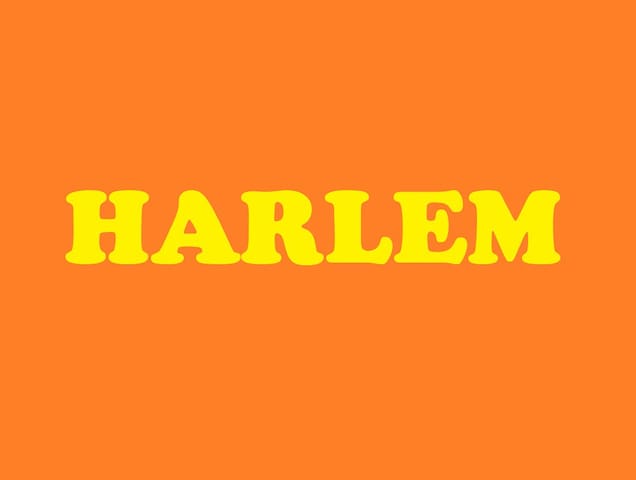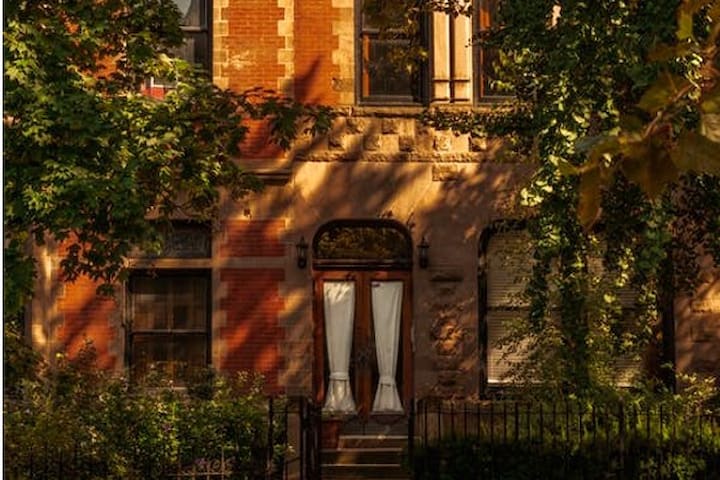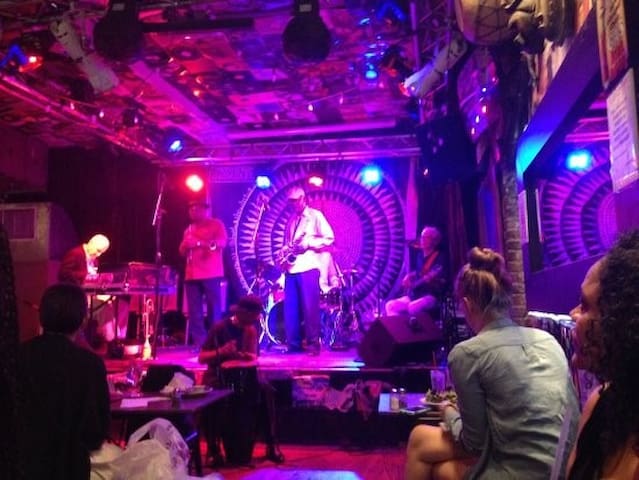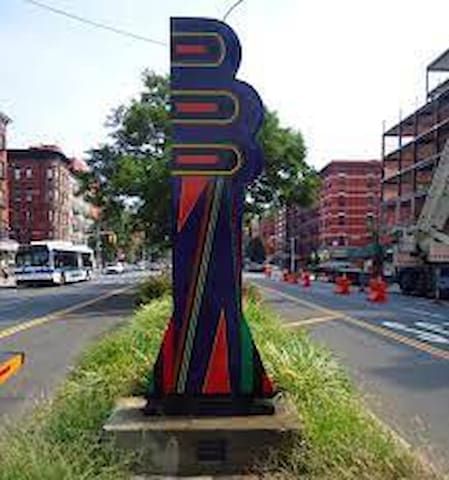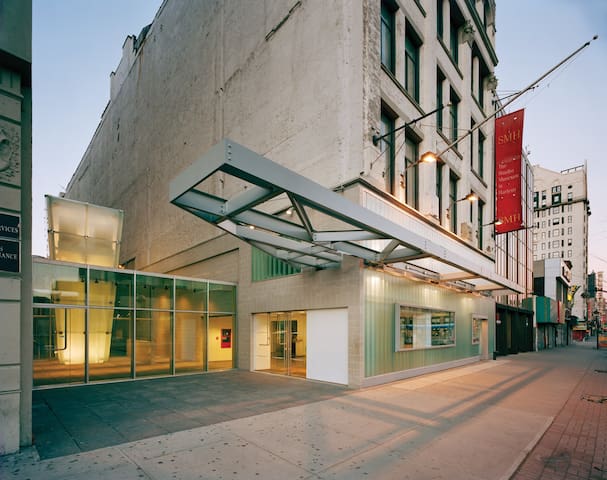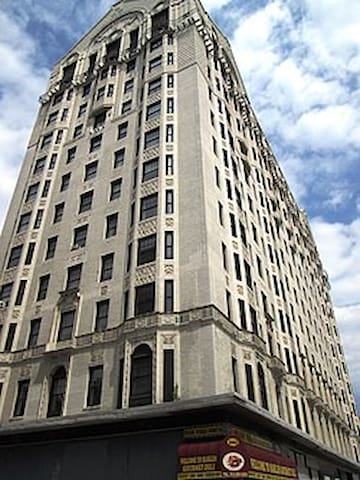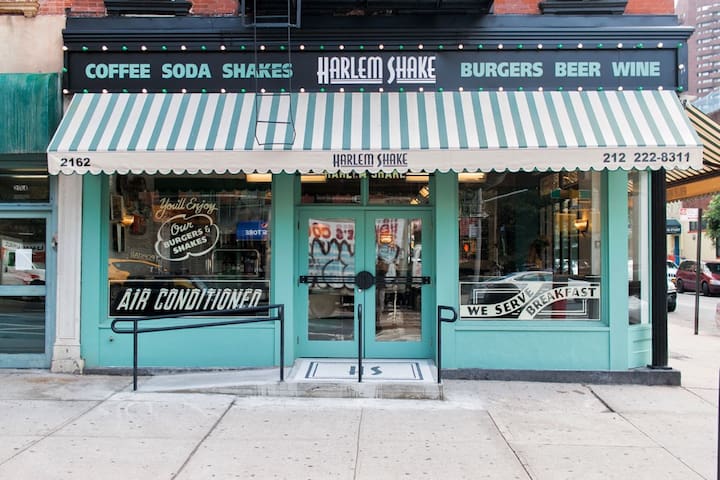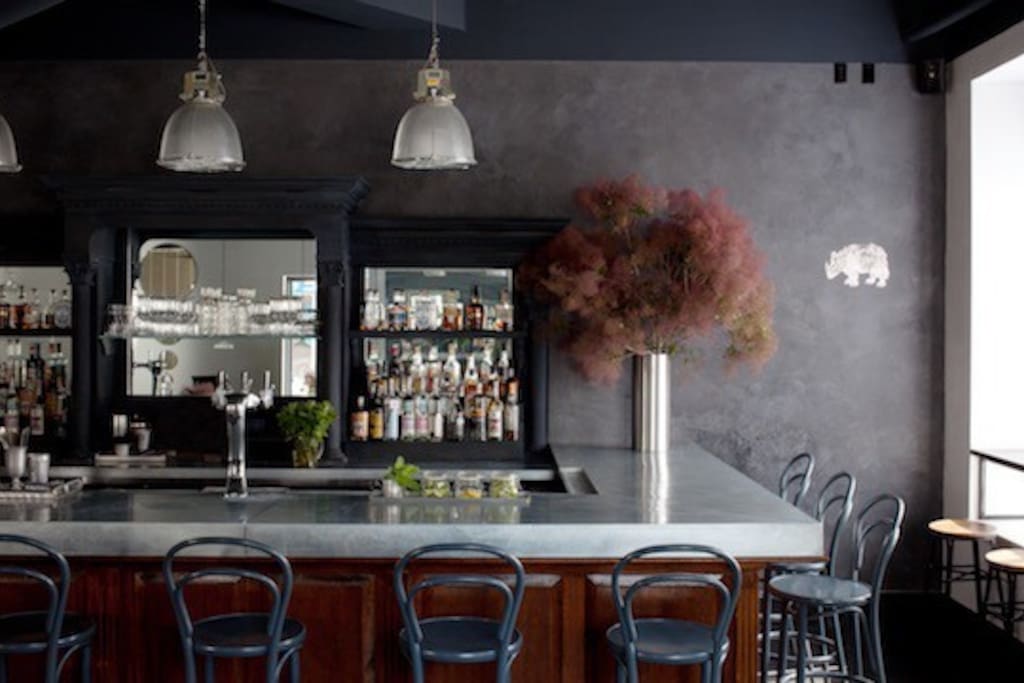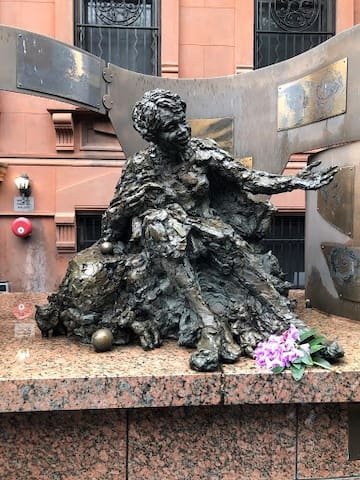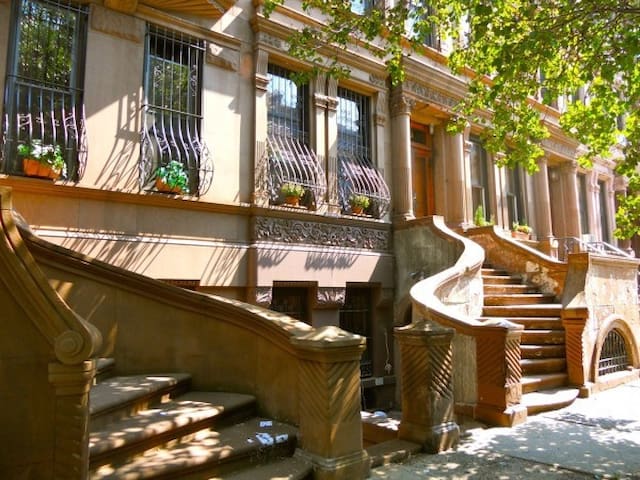HARLEM
Harlem isn’t just one of the most historic neighborhoods in New York City. It’s also one of the liveliest.
The word “Harlem” alone evokes images of legendary nightspots, where great musicians filled the night with hot jazz. For others, it brings thoughts of the notorious ghetto: decrepit, dirty, and crime-ridden.
While both are part of its past, Harlem today has entered a new era. Yes, Harlem is still a bit rough around the edges, with some abandoned buildings, poverty, and litter. But the streets are safer, and many of Harlem’s architectural treasures have been restored. New restaurants, stores, and hotels are opening—and thriving.
160 Recomendado por los habitantes de la zona
Harlem
The word “Harlem” alone evokes images of legendary nightspots, where great musicians filled the night with hot jazz. For others, it brings thoughts of the notorious ghetto: decrepit, dirty, and crime-ridden.
While both are part of its past, Harlem today has entered a new era. Yes, Harlem is still a bit rough around the edges, with some abandoned buildings, poverty, and litter. But the streets are safer, and many of Harlem’s architectural treasures have been restored. New restaurants, stores, and hotels are opening—and thriving.
HISTORY:
Founded by Dutch settlers in the 1650s, Harlem was a rural village for two centuries.
When railroads linked Harlem to the city in the 1870s, though, buildings sprang up—including tenements for immigrants in the east, and elegant row houses in the center for affluent whites.
At the turn of the century, the coming of the subway led to a building boom that went bust, leaving blocks of houses and apartments empty. New York City’s African-American residents moved uptown after WWI. Soon, Harlem was the “Black Capital of America.”
The Harlem Renaissance flourished in the 1920s, when Harlemites produced exceptional art, literature, poetry, theater, and of course music. People flocked to nightclubs like the Cotton Club and the Savoy Ballroom to hear jazz by Duke Ellington, Count Basie, and Cab Calloway.
But the Great Depression devastated Harlem, and later race riots inflicted greater damage on the neighborhood. Decades of poverty and neglect left Harlem a dangerous, decaying ghetto.
In the 1990s, New Yorkers began buying and restoring Harlem’s brownstones. The city renovated abandoned buildings for affordable housing, and folks moved to the neighborhood for its reasonable rents.
160 Recomendado por los habitantes de la zona
Harlem
HISTORY:
Founded by Dutch settlers in the 1650s, Harlem was a rural village for two centuries.
When railroads linked Harlem to the city in the 1870s, though, buildings sprang up—including tenements for immigrants in the east, and elegant row houses in the center for affluent whites.
At the turn of the century, the coming of the subway led to a building boom that went bust, leaving blocks of houses and apartments empty. New York City’s African-American residents moved uptown after WWI. Soon, Harlem was the “Black Capital of America.”
The Harlem Renaissance flourished in the 1920s, when Harlemites produced exceptional art, literature, poetry, theater, and of course music. People flocked to nightclubs like the Cotton Club and the Savoy Ballroom to hear jazz by Duke Ellington, Count Basie, and Cab Calloway.
But the Great Depression devastated Harlem, and later race riots inflicted greater damage on the neighborhood. Decades of poverty and neglect left Harlem a dangerous, decaying ghetto.
In the 1990s, New Yorkers began buying and restoring Harlem’s brownstones. The city renovated abandoned buildings for affordable housing, and folks moved to the neighborhood for its reasonable rents.
Want to explore Harlem? Just remember that New York actually has several Harlems, stretching from the East River to the Hudson River above Central Park but below Washington Heights: there’s Spanish Harlem, or “El Barrio” (between 5th Avenue to the East River); West Harlem (includes the neighborhoods of Morningside Heights and Hamilton Heights) and Central Harlem (where our house is located).
This tour focuses on North and South Central Harlem, the historic center of African-American culture in New York (and America).
Tour Length: 4 Hours
Suggested time for Tour: Mornings
160 Recomendado por los habitantes de la zona
Harlem
Want to explore Harlem? Just remember that New York actually has several Harlems, stretching from the East River to the Hudson River above Central Park but below Washington Heights: there’s Spanish Harlem, or “El Barrio” (between 5th Avenue to the East River); West Harlem (includes the neighborhoods of Morningside Heights and Hamilton Heights) and Central Harlem (where our house is located).
This tour focuses on North and South Central Harlem, the historic center of African-American culture in New York (and America).
Tour Length: 4 Hours
Suggested time for Tour: Mornings
North Harlem
Take the #3 Subway train to the 135th stop.
This self-guided walking tour begins at 135th Street. The 135th Street to the west (between Lenox Ave. and Adam Clayton Powell Blvd.–look for the YMCA) was one of Harlem’s first African-American enclaves. This is where Philip A. Payton broke the color barrier by offering apartments to NYC’s Black citizens—their first decent housing in the city’s 250-year history.
The northwest corner of this intersection was once Speakers’ Corner, where charismatic activists like Marcus Garvey and A. Philip Randolph extolled passersby from atop their soapboxes.
The large brick building is the Schomburg Center for Research in Black Culture, the nation’s largest research library devoted to cultures of people of African descent. The Center also presents exhibits, performances, forums, and events showcasing Black culture. Look in the library for the four Aaron Douglas murals, which typify the spirit of the Harlem Renaissance. (Plus, there are convenient restrooms near the entrance doors).
186 Recomendado por los habitantes de la zona
Schomburg Center for Research in Black Culture
515 Malcolm X BlvdThe large brick building is the Schomburg Center for Research in Black Culture, the nation’s largest research library devoted to cultures of people of African descent. The Center also presents exhibits, performances, forums, and events showcasing Black culture. Look in the library for the four Aaron Douglas murals, which typify the spirit of the Harlem Renaissance. (Plus, there are convenient restrooms near the entrance doors).
Across Lenox Ave is Harlem Hospital, where Martin Luther King, Jr. was saved after being stabbed by a deranged Harlemite. Reproduced on its new, glass-encased wing is a montage from the hospital’s historic WPA murals, which will be restored and displayed in the new building. The figure in white is Cab Calloway “beatin’ the band.”
19 Recomendado por los habitantes de la zona
NYC Health + Hospitals/Harlem
506 Lenox AveAcross Lenox Ave is Harlem Hospital, where Martin Luther King, Jr. was saved after being stabbed by a deranged Harlemite. Reproduced on its new, glass-encased wing is a montage from the hospital’s historic WPA murals, which will be restored and displayed in the new building. The figure in white is Cab Calloway “beatin’ the band.”
Take a brief detour west on 136th Street to 107 W136th St, to see brownstones converted into an evangelical church and a funeral home, respectively. The “garden level” and/or basements of many Harlem brownstones were converted into funeral parlors, houses of worship, shops, bistros, intimate clubs—and, during Prohibition, speakeasies!
Return to Lenox and continue to 138th Street, then turn left and walk west.
107 W 136th St
107 West 136th StreetTake a brief detour west on 136th Street to 107 W136th St, to see brownstones converted into an evangelical church and a funeral home, respectively. The “garden level” and/or basements of many Harlem brownstones were converted into funeral parlors, houses of worship, shops, bistros, intimate clubs—and, during Prohibition, speakeasies!
Return to Lenox and continue to 138th Street, then turn left and walk west.
Founded in 1808 by African Americans and Ethiopian merchants unwilling to accept the segregated seating of other churches, the Abyssinian (which refers to the ancient name for Ethiopia) is one of the nation’s oldest and most influential African-American congregations.
Since erecting this church in 1923, the Abyssinian has been a force for social justice and economic development in Harlem. It is also the best place to hear Gospel music. It is often closed to the public, so attending a Sunday service may be your only option for entrance. Be sure to read the Abyssinian’s instructions for first-time visitors (www.abyssinian.org) and make your reservation for attendance.
TIP: Reserve your tickets online several days in advance of Sunday as this church is quite popular.
94 Recomendado por los habitantes de la zona
Abyssinian Baptist Church
132 W 138th StFounded in 1808 by African Americans and Ethiopian merchants unwilling to accept the segregated seating of other churches, the Abyssinian (which refers to the ancient name for Ethiopia) is one of the nation’s oldest and most influential African-American congregations.
Since erecting this church in 1923, the Abyssinian has been a force for social justice and economic development in Harlem. It is also the best place to hear Gospel music. It is often closed to the public, so attending a Sunday service may be your only option for entrance. Be sure to read the Abyssinian’s instructions for first-time visitors (www.abyssinian.org) and make your reservation for attendance.
TIP: Reserve your tickets online several days in advance of Sunday as this church is quite popular.
The decaying brick buildings at Adam Clayton Powell and 138th St. were the location of the crack den in Spike Lee’s film “Jungle Fever.” But they also were once the Renaissance Ballroom and Casino, a Black-owned entertainment complex that included a movie theater, ballroom, billiards parlor, and space for sporting events. During its heyday in the 1920s, “the cream of Harlem” held social events here, revelers danced the Charleston and Black Bottom, and America’s first African-American professional basketball team, the Harlem Renns, played here. It also hosted performances by Duke Ellington, Fletcher Henderson, and Ella Fitzgerald.
West 138th Street & Adam Clayton Powell Junior Boulevard
The decaying brick buildings at Adam Clayton Powell and 138th St. were the location of the crack den in Spike Lee’s film “Jungle Fever.” But they also were once the Renaissance Ballroom and Casino, a Black-owned entertainment complex that included a movie theater, ballroom, billiards parlor, and space for sporting events. During its heyday in the 1920s, “the cream of Harlem” held social events here, revelers danced the Charleston and Black Bottom, and America’s first African-American professional basketball team, the Harlem Renns, played here. It also hosted performances by Duke Ellington, Fletcher Henderson, and Ella Fitzgerald.
At Adam Clayton Powell and 139th Street, turn left (west) onto Strivers Row, the two-block stretch of row houses with two unique features: their elegant, unified designs, and the private alleys behind each row (rare for New York). Architect Stanford White designed the row on the north side of 139th Street.
Built in 1891, most of these homes remained empty until affluent African Americans (“Strivers”) bought them in the 1920s. Eubie Blake, W.C. Handy, Fletcher Henderson, and Alpha Phi Alpha (the nation’s first black fraternity) all resided on the row.
70 Recomendado por los habitantes de la zona
Strivers' Row
At Adam Clayton Powell and 139th Street, turn left (west) onto Strivers Row, the two-block stretch of row houses with two unique features: their elegant, unified designs, and the private alleys behind each row (rare for New York). Architect Stanford White designed the row on the north side of 139th Street.
Built in 1891, most of these homes remained empty until affluent African Americans (“Strivers”) bought them in the 1920s. Eubie Blake, W.C. Handy, Fletcher Henderson, and Alpha Phi Alpha (the nation’s first black fraternity) all resided on the row.
Wander along the block to Frederick Douglass Blvd. The street comes to an abrupt end with a park a block and a half west. This is St. Nicholas Park, which is built on the massive ridge of Manhattan bedrock that separates Harlem Heights from the plain of Harlem. The large Gothic building on the summit is City College, the oldest public college in the State of New York, and one of the first five public universities in the nation.
Walking south down the boulevard, you can look into the private alley between the row houses of 139th and 138th Streets.
166 Recomendado por los habitantes de la zona
The City College of New York
160 Convent AveWander along the block to Frederick Douglass Blvd. The street comes to an abrupt end with a park a block and a half west. This is St. Nicholas Park, which is built on the massive ridge of Manhattan bedrock that separates Harlem Heights from the plain of Harlem. The large Gothic building on the summit is City College, the oldest public college in the State of New York, and one of the first five public universities in the nation.
Walking south down the boulevard, you can look into the private alley between the row houses of 139th and 138th Streets.
For lovers of the Broadway show Hamilton, continue north until you reach 141 street to visit Alexander Hamilton's residence - ''Hamilton Grange'' maintained by the National Parks Service.
Born and raised in the West Indies, Hamilton came to New York in 1772 at age 17 to study finance at King's College (now Columbia University). After the Revolutionary war, as a member of Congress, Hamilton was instrumental in creating the new Constitution. As co-author of the Federalist Papers, he was indispensable in the effort to get the Constitution adopted. He was the first Secretary of the Treasury (1789-1795) originating the plans for funding the national debt, securing federal credit, encouraging expansion of manufacturing and organizing the federal bank.
Hamilton commissioned architect John McComb Jr. to design a Federal style country home that was on a sprawling 32 acre estate. This house was completed in 1802 and named ''The Grange'' after the Hamilton family's ancestral home in Scotland, but served as his home for only two years, before he was mortally wounded in a duel.
Turn around and go back south for six blocks and head east until you reach Adam Clayton Powell Jr. Blvd.
175 Recomendado por los habitantes de la zona
Hamilton Grange National Memorial
414 W 141st StFor lovers of the Broadway show Hamilton, continue north until you reach 141 street to visit Alexander Hamilton's residence - ''Hamilton Grange'' maintained by the National Parks Service.
Born and raised in the West Indies, Hamilton came to New York in 1772 at age 17 to study finance at King's College (now Columbia University). After the Revolutionary war, as a member of Congress, Hamilton was instrumental in creating the new Constitution. As co-author of the Federalist Papers, he was indispensable in the effort to get the Constitution adopted. He was the first Secretary of the Treasury (1789-1795) originating the plans for funding the national debt, securing federal credit, encouraging expansion of manufacturing and organizing the federal bank.
Hamilton commissioned architect John McComb Jr. to design a Federal style country home that was on a sprawling 32 acre estate. This house was completed in 1802 and named ''The Grange'' after the Hamilton family's ancestral home in Scotland, but served as his home for only two years, before he was mortally wounded in a duel.
Turn around and go back south for six blocks and head east until you reach Adam Clayton Powell Jr. Blvd.
At 135th Street, you’ll see the large, historic Harlem YMCA, where writers Claude McKay, Langston Hughes, and Ralph Ellison once lived, Jackie Robinson coached local kids, and James Earl Jones, Alvin Ailey, and Sidney Poitier performed in the Little Theater.
Continue southward for 10 more blocks on Adam Clayton Powell Blvd.
11 Recomendado por los habitantes de la zona
Harlem YMCA Health Club
180 W 135th StAt 135th Street, you’ll see the large, historic Harlem YMCA, where writers Claude McKay, Langston Hughes, and Ralph Ellison once lived, Jackie Robinson coached local kids, and James Earl Jones, Alvin Ailey, and Sidney Poitier performed in the Little Theater.
Continue southward for 10 more blocks on Adam Clayton Powell Blvd.
The block of W. 133rd Street to your left was known as “Swing Street,” because it was lined with clubs, speakeasies, and after-hour hangouts. At #2271 is the Shrine Bar/Restaurant, a popular jazz and world music club. A typical hair-braiding salon is at #2253, and #2251 is an African Caribbean Market, selling imported foods and African movies.
West 133rd Street
West 133rd StreetThe block of W. 133rd Street to your left was known as “Swing Street,” because it was lined with clubs, speakeasies, and after-hour hangouts. At #2271 is the Shrine Bar/Restaurant, a popular jazz and world music club. A typical hair-braiding salon is at #2253, and #2251 is an African Caribbean Market, selling imported foods and African movies.
On the avenue’s island at 131st Street is the brightly colored marker where the Tree of Hope once stood. Performers at the famed Lafayette Theater (formally on 132nd St) believed the tree bestowed good luck. Its stump is now in the wings of the Apollo Theater, where performers touch it before taking the stage.
Beginning at the southwest corner are a number of Public Housing towers (or “projects”) covering five city blocks.
Tree of Hope
Adam Clayton Powell Junior BoulevardOn the avenue’s island at 131st Street is the brightly colored marker where the Tree of Hope once stood. Performers at the famed Lafayette Theater (formally on 132nd St) believed the tree bestowed good luck. Its stump is now in the wings of the Apollo Theater, where performers touch it before taking the stage.
Beginning at the southwest corner are a number of Public Housing towers (or “projects”) covering five city blocks.
At the southwest corner of 126th Street is the Alhambra Ballroom, which opened in 1905 as a lavish vaudeville theater. The ballroom was added in 1926, and featured performances by Bessie Smith, Jelly Roll Morton, and Billie Holiday.
BALLROOM @ THE ALHAMBRA THEATRE
2116 Adam Clayton Powell Junior BoulevardAt the southwest corner of 126th Street is the Alhambra Ballroom, which opened in 1905 as a lavish vaudeville theater. The ballroom was added in 1926, and featured performances by Bessie Smith, Jelly Roll Morton, and Billie Holiday.
125th Street is the Harlem’s historic commercial heart. On the northeast corner is the behemoth Adam Clayton Powell Jr. State Office Building, with the statue of its preacher and statesman namesake. The open plaza is often the site of community gatherings, including the celebration of President Obama’s election, a vigil for Michael Jackson, and numerous political/civil demonstrations.
Adam Clayton Powell Jr State Office Building
163 West 125th Street125th Street is the Harlem’s historic commercial heart. On the northeast corner is the behemoth Adam Clayton Powell Jr. State Office Building, with the statue of its preacher and statesman namesake. The open plaza is often the site of community gatherings, including the celebration of President Obama’s election, a vigil for Michael Jackson, and numerous political/civil demonstrations.
Across 125th Street is the Studio Museum in Harlem, dedicated to the works of Black artists, from the 19th Century to contemporary. The museum features a permanent collection, exhibitions, and events; it also has a nice café, and free admission on Sundays.
239 Recomendado por los habitantes de la zona
The Studio Museum in Harlem
144 West 125th StreetAcross 125th Street is the Studio Museum in Harlem, dedicated to the works of Black artists, from the 19th Century to contemporary. The museum features a permanent collection, exhibitions, and events; it also has a nice café, and free admission on Sundays.
At the southwest corner is the Hotel Theresa, known as the “Waldorf Astoria of Harlem.” It’s hosted celebrities like Joe Louis, Bill “Bojangles” Robinson, and stars of the Apollo Theater. Many civil rights leaders also had offices in the hotel, including Philip Randolph and Malcolm X.
And Fidel Castro checked in here while attending a U.N. session. (After he was evicted from a midtown hotel for keeping live chickens in his room! :)
Hotel Theresa
2070-2080 Adam Clayton Powell Junior BoulevardAt the southwest corner is the Hotel Theresa, known as the “Waldorf Astoria of Harlem.” It’s hosted celebrities like Joe Louis, Bill “Bojangles” Robinson, and stars of the Apollo Theater. Many civil rights leaders also had offices in the hotel, including Philip Randolph and Malcolm X.
And Fidel Castro checked in here while attending a U.N. session. (After he was evicted from a midtown hotel for keeping live chickens in his room! :)
The Apollo Theater’s slogan, “where legends are made,” is no empty boast. This is where Ella Fitzgerald, Sarah Vaughn, James Brown, Gladys Knight and the Pips, Jimi Hendrix, Stevie Wonder, and the Jackson Five launched their careers.
It’s also launched some of the greatest stars of jazz, R&B, and hip-hop. Built in 1914 as a burlesque house for a whites-only audience, the theater still hides racy murals behind the red-velvet wall coverings. In 1934, it became the “125th Street Apollo,” a variety music hall open to everyone.
Today, the raucous Amateur Night at the Apollo (where so many stars have been discovered) still takes place every Wednesday night. Excellent historic tours of the theater are also available.
Consult website for tickets and events: www.apollotheaters.org
893 Recomendado por los habitantes de la zona
Teatro Apollo
253 W 125th StThe Apollo Theater’s slogan, “where legends are made,” is no empty boast. This is where Ella Fitzgerald, Sarah Vaughn, James Brown, Gladys Knight and the Pips, Jimi Hendrix, Stevie Wonder, and the Jackson Five launched their careers.
It’s also launched some of the greatest stars of jazz, R&B, and hip-hop. Built in 1914 as a burlesque house for a whites-only audience, the theater still hides racy murals behind the red-velvet wall coverings. In 1934, it became the “125th Street Apollo,” a variety music hall open to everyone.
Today, the raucous Amateur Night at the Apollo (where so many stars have been discovered) still takes place every Wednesday night. Excellent historic tours of the theater are also available.
Consult website for tickets and events: www.apollotheaters.org
Langston Hughes House
20 East 127th Street
http://www.langstonhughessociety.org/
Take a short 2 block detour north on Lenox until you reach the home of Langston Hughes. American poet, playwright and novelist, Langston Hughes was one of the most influential writers of the 20th century, particularly known for his insightful, colorful portrayals of black life in America from 1920-1960s. He wrote novels, short stories and plays, as well as poetry, and is also known for his engagement with the world of jazz and the influence it had on his writing, as in ''Montage of a Dream Deferred.'' His life and work were enormously important in shaping the artistic contributions of the Harlem Renaissance.
The brownstone is in the Italianate style, built in 1869. Has 3-story façade, fronted by locally mined “brown stone” masonry material, which is how Brownstones received their name
Unfortunately, his home is privately owned and not open to the public, however the Langston Hughes Society holds public events and readings through-out the year and in several states.
20 E 127th St
20 East 127th StreetLangston Hughes House
20 East 127th Street
http://www.langstonhughessociety.org/
Take a short 2 block detour north on Lenox until you reach the home of Langston Hughes. American poet, playwright and novelist, Langston Hughes was one of the most influential writers of the 20th century, particularly known for his insightful, colorful portrayals of black life in America from 1920-1960s. He wrote novels, short stories and plays, as well as poetry, and is also known for his engagement with the world of jazz and the influence it had on his writing, as in ''Montage of a Dream Deferred.'' His life and work were enormously important in shaping the artistic contributions of the Harlem Renaissance.
The brownstone is in the Italianate style, built in 1869. Has 3-story façade, fronted by locally mined “brown stone” masonry material, which is how Brownstones received their name
Unfortunately, his home is privately owned and not open to the public, however the Langston Hughes Society holds public events and readings through-out the year and in several states.
Food scene
After shopping and sightseeing on 125th Street, head east towards Lenox Ave and check out three excellent restaurants: the acclaimed Red Rooster (owned by Marcus Samuelsson, who was the White House Executive Chef to President Obama and Food Network star), Corner Social, or the Harlem Shake on 124th and Lenox which is responsible for starting the Harlem Shake viral dance campaign on social media in 2013).
212 Recomendado por los habitantes de la zona
Harlem Shake
100 W 124th StAfter shopping and sightseeing on 125th Street, head east towards Lenox Ave and check out three excellent restaurants: the acclaimed Red Rooster (owned by Marcus Samuelsson, who was the White House Executive Chef to President Obama and Food Network star), Corner Social, or the Harlem Shake on 124th and Lenox which is responsible for starting the Harlem Shake viral dance campaign on social media in 2013).
There’s also plenty of new, high-end businesses on Frederick Douglas, including W’s Aloft Hotel, Vinateria (a 2 Michelin Star restaurant), wine stores, Patisserie des Ambassades, Levain Bakery (rated as ‘NYC’s best cookies’ for 5yrs), and Harlem Tavern. There are many restaurants, cafes and bars on Frederick Douglas below 125th Street, so make sure to explore this part of Harlem at lunch or dinner time.
169 Recomendado por los habitantes de la zona
VINATERÍA
2211 Frederick Douglass BlvdThere’s also plenty of new, high-end businesses on Frederick Douglas, including W’s Aloft Hotel, Vinateria (a 2 Michelin Star restaurant), wine stores, Patisserie des Ambassades, Levain Bakery (rated as ‘NYC’s best cookies’ for 5yrs), and Harlem Tavern. There are many restaurants, cafes and bars on Frederick Douglas below 125th Street, so make sure to explore this part of Harlem at lunch or dinner time.
South Harlem
Ready to continue? Great! Let’s go to South Harlem (SoHa).
Walk south down Lenox Avenue, lined with incredible brownstones and churches, all built for the wealthy German-Jewish community in the 1880s. Our tour of South Harlem begins on 123rd Street and Lenox Avenue.
Lenox Avenue
Lenox AvenueWalk south down Lenox Avenue, lined with incredible brownstones and churches, all built for the wealthy German-Jewish community in the 1880s. Our tour of South Harlem begins on 123rd Street and Lenox Avenue.
The church on the corner of 123rd street, designated as a NYC Historic Landmark in 1971, and home to the Boys Choir of Harlem since 1968 was built in 1887, by the Harlem Reformed Dutch Church. The building was named the Second Collegiate Church of Harlem, to serve the wealthier white families living in west Harlem. Architect John Rochester Thomas designed the late Victorian Gothic Revival building faced in yellow Ohio sandstone. Due to its style and building material, it is affectionately called “the Sandcastle” by locals.
By the late 1920s, the demographics of Harlem had changed, and many white Protestants relocated to other areas. In 1930 the building was leased then sold to the Ephesus Adventist congregation and has functioned as a Seventh Day Adventist Church since that time.
Worship service is not open to the general public; however, you may visit during one of the church’s many community events.
New York Ephesus Seventh-Day Adventist Church
101 West 123rd StreetThe church on the corner of 123rd street, designated as a NYC Historic Landmark in 1971, and home to the Boys Choir of Harlem since 1968 was built in 1887, by the Harlem Reformed Dutch Church. The building was named the Second Collegiate Church of Harlem, to serve the wealthier white families living in west Harlem. Architect John Rochester Thomas designed the late Victorian Gothic Revival building faced in yellow Ohio sandstone. Due to its style and building material, it is affectionately called “the Sandcastle” by locals.
By the late 1920s, the demographics of Harlem had changed, and many white Protestants relocated to other areas. In 1930 the building was leased then sold to the Ephesus Adventist congregation and has functioned as a Seventh Day Adventist Church since that time.
Worship service is not open to the general public; however, you may visit during one of the church’s many community events.
Clara McBride Hale, also known as Mother Hale, was an American humanitarian. Hale lived in Harlem, where she retired from working as a domestic and opened her house “Hale House Center” to help addicted children in 1969. She housed over 1,000 babies and young children who were born addicted to drugs, children born with HIV, and children whose parents had died of AIDS. Her work with kids extended beyond just the care, as she started various community outreach programs: helping over 10,000 families and children in her lifetime.
“It was simple,” she said "hold them, rock them, love them and tell them how great they are."
In 1985, President Ronald Reagan honored Clara Hale as an American hero in his State of the Union Address. In 1986, the Women's International Center gave Hale the Living Legacy Award which honors women for their great contributions to humanity.
The Hale House is currently under construction and tours are not allowed.
Hale House Center, Inc.
Clara McBride Hale, also known as Mother Hale, was an American humanitarian. Hale lived in Harlem, where she retired from working as a domestic and opened her house “Hale House Center” to help addicted children in 1969. She housed over 1,000 babies and young children who were born addicted to drugs, children born with HIV, and children whose parents had died of AIDS. Her work with kids extended beyond just the care, as she started various community outreach programs: helping over 10,000 families and children in her lifetime.
“It was simple,” she said "hold them, rock them, love them and tell them how great they are."
In 1985, President Ronald Reagan honored Clara Hale as an American hero in his State of the Union Address. In 1986, the Women's International Center gave Hale the Living Legacy Award which honors women for their great contributions to humanity.
The Hale House is currently under construction and tours are not allowed.
Explore Marcus Garvey Historic District, beginning at 122nd Street, between Lenox Avenue and Marcus Garvey Park. The streets are lined by some of the most expensive and lavish brownstones in Harlem, once called "Doctors' Row".
154 Recomendado por los habitantes de la zona
Parque Marcus Garvey
Mount Morris Park WestExplore Marcus Garvey Historic District, beginning at 122nd Street, between Lenox Avenue and Marcus Garvey Park. The streets are lined by some of the most expensive and lavish brownstones in Harlem, once called "Doctors' Row".
Then continue west towards 123rd St and Frederick Douglass Blvd. (aka 7th Avenue), where you’ll find the Harriet Tubman Monument marking the final Northern-most destination of the Underground Railroad for escaped African slaves before the American Civil War ended slavery on January 1st 1863.
10 Recomendado por los habitantes de la zona
Swing Low: Harriet Tubman Memorial
Frederick Douglass BoulevardThen continue west towards 123rd St and Frederick Douglass Blvd. (aka 7th Avenue), where you’ll find the Harriet Tubman Monument marking the final Northern-most destination of the Underground Railroad for escaped African slaves before the American Civil War ended slavery on January 1st 1863.
Consejos para la ciudad
Costumbres y cultura
TOUR NOTE
Visitors flock to Harlem Church services, seeking an authentic cultural experience (which it certainly is!) and world-renowned Gospel. However, it’s important to remember that these are religious services, and not simply a music performance. The congregations are devout and take their worship seriously. Therefore, dress conservatively and never behave in a manner that is distracting to others. Visitors must arrive on time and remain for the entire service. Most churches will require advanced online reservations. Talking, photos/video during the service is not acceptable.
No te pierdas
Sunday church services available in Harlem
In addition to Abyssinian Baptist, visitor-friendly churches include Greater Refuge Temple, Mount Neboh Baptist, and United House of Prayer for All People.
Before attending mass, consult the church website for tickets and covid19 health restrictions. Reservations usually must be made several days in advance.



